When an employee leaves a company, they usually take with them proprietary secrets and other insider knowledge. In order to protect the business, many employers have their soon-to-be former worker sign a confidential separation agreement. These allow both parties to move forward with a shared understanding of what constitutes privileged information. They also clarify other important parting business, such as what the company considers to be non-competition and what constitutes a fair severance package.
It’s important that these are carefully drafted to smooth the exit and allow everyone to feel like the separation happened on good terms. This blog post offers an analysis of a sample Confidential Separation Agreement & General Release of All Claims to overview what can make these contracts successful. By digging into this one example, we also uncover some universal drafting lessons that can take the guesswork out of writing your next contract.
Questions in this Episode
- How can drafters get rid of the redundancy that comes with legal language in documents?
- What is negotiable and what isn’t in an employer-employee situation?
- How should drafters deal with the continuing obligations clause?
- What language can drafters use to write clauses that are specific to the contract?
- How can the risk of adapting to the moment be balanced against “we have to do thousands of these documents”?
Don’t Bring up the NDA
If you’re an employer and you have to let someone go, you’ll come across a confidential separation agreement. Usually, it’s someone who knows something that you don’t want the rest of the public to know, or if you’re one of the unfortunate people who is being let go, you might see this as well, depending on your position in the company. The question is what information have you had access to while working there?
This person is walking away with nearly half a million dollars. So, they’re not going to be too upset. Having said that, there is a confidential aspect to it.
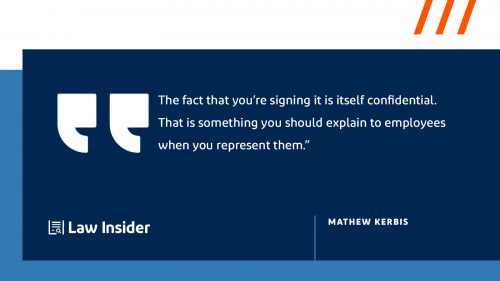
|
6.1 Confidential Separation Information. Employee agrees that the terms and conditions of this Agreement, as well as the discussions that led to the terms and conditions of this Agreement (collectively referred to as the “Confidential Separation Information”) are intended to remain confidential between Employee and Company. Employee further agrees that Employee will not disclose the Confidential Separation Information to any other persons, except that Employee may disclose such information to Employee’s immediate family members and to Employee’s attorney(s) and accountant(s), if any, to the extent needed for legal advice or income tax planning purposes. When releasing this information to any such person, Employee shall advise the person receiving the information of its confidential nature. Neither Employee, nor anyone to whom the Confidential Separation Information has been disclosed will respond to, or in any way participate in or contribute to, any public discussion, notice or other publicity concerning the Confidential Separation Information. Without limiting the generality of the foregoing, Employee specifically agrees that neither Employee, Employee’s immediate family, Employee’s attorney nor Employee’s accountant, if any, shall disclose the Confidential Separation Information to any current or former employees of the Company or other Released Parties. Nothing in this paragraph will preclude Employee from disclosing information required in response to a subpoena duly issued by a court of law or a government agency having jurisdiction or power to compel such disclosure, or from giving full, truthful and cooperative answers in response to a duly issued subpoena. |
You can’t tell your partner, parents, or infant child. The way this document is written, you can’t even discuss the fact that it exists. That is, of course, pending any kind of litigation, and while this particular confidential separation agreement does not address it, many are drafted where it states that unless you are responding to a lawful subpoena. Even so, in most cases, that must be cleared with in-house counsels before you even disclose that this document exists. Only you and your employer should be aware of everything that exists. That’s the end of it.
Get Rid of the Redundancy
There can be a lot of redundancy, especially in litigation, with motions and pleadings like “the plaintiff,” and “the defendant.” It’s a proper noun. That’s like saying “the Walmart,” which doesn’t quite fit.
Does it alter the contract’s meaning? No. Is it a little confusing? It is, indeed. Is it technically incorrect? Yes.
Fewer words in a contract are always a good thing. - Mathew Kerbis #ContractTeardown Click To Tweet
It’s a good thing if you can make a contract less wordy and shorter. It’s best to leave out the “the” before company. They don’t do that with the “employee,” so this contract is properly drafted in terms of the proper use of the capital “employee.” If a term is defined at the start of a contract, instead of XYZ company, we’re calling it company in quotes or whatever that defined term is, there should be no “the” in front of it. Get rid of “the”.
Everything is Negotiable
The entire sociability when representing employees, as they ask in this type of situation, “I have to sign it, right?” They think they don’t have a choice. It’s just what the company is offering. It’s as though your severance payment is going to be however many years you worked here. While this may be company policy or what is stated in every severance agreement, everything is negotiable.
|
2.1 Severance Payment. Company agrees to provide Employee the equivalent of eighteen (18) months base wages ($503,250.00), less all applicable federal and state income and employment taxes (“Severance Payment”). The Severance Payment will be made in the form of a lump sum payment on the first payday following the Effective Date, as described in paragraph 13. |
You may be able to get a higher number depending on the type of leverage you have against a company, such as specialized knowledge. When representing an employee, you should always negotiate a higher number. On the employer side, you want them to believe, “Oh, no, this is what we do for everyone.”
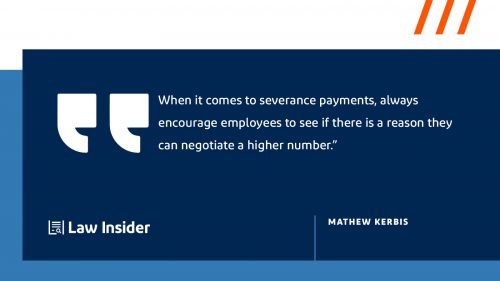
Are Continuing Obligations Acceptable?
The non-solicitation clause in this contract does not allow taking any employees for the term of one year, which is the continuing obligation after separation. You are not permitted to hire any of the employees to work on a competing product for at least one year.
|
6.3 Continuing Obligations. Employee further agrees to comply with the surviving provisions of the offer letter and such other employee-related documentation executed as part of Employee’s employment with the Company including without limitation the Employee Nondisclosure and Assignment Agreement and/or the Proprietary Information and Inventions Agreement (collectively, “Employment Agreements”). Such continuing obligations include, but are not limited to, promises to protect all confidential and proprietary information of Company and promises not to solicit any Company employees for a period of one (1) year following the Separation Date. |
The term of that is also negotiable, especially with things like non-compete agreements, as you get into state laws and what is and isn’t a contractual amount of time. This is not stated in the contract but it’s something you should consider. There is always case law to consult when advising an employer and employee about this type of clause and time period. There are sometimes laws that specify how much time is allowed and how much is not. Know your state law as well as your case law.
If you are the employee, you can negotiate that the one-year time period in this contract is reduced. You could make an exception for Jane Smith, for example, because you need to bring her with you. She is unrivaled.
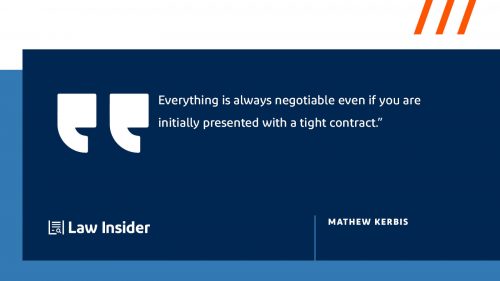
It is quite normal to avoid discussing the company in the future. Every state will have different rules, and there will be different case laws. It’s an acceptable term to keep everything confidential forever, especially with such a large payout as this, which is enough consideration that it’s exempt. There could be trade secrets and other sensitive information. Every situation is different, and context matters when it comes to enforceability.
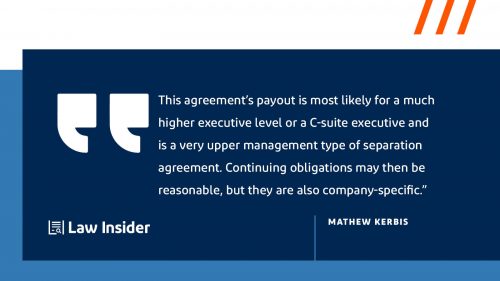
Enforcement
If you notice the second tip we gave about a “the” that shouldn’t be there something similar is happening here. Section nine discusses the suspension of payments in the event of a breach of this contract. The way this is worded implies that there is more than one payment, whereas if you read the payment clause of how the payment is made, it is made in a single lump sum payment on a very specific date.
|
9. Enforcement. If Employee breaches any of the terms of this Agreement, Company will immediately cease making the payments described in paragraph 2 to the extent those payments have not yet been made, to the fullest extent permitted by law. This shall in no way limit Company’s right to pursue all legal and equitable remedies available to it as a result of Employee’s breach of this Agreement. This enforcement provision shall not apply to an action brought by Employee to challenge the enforceability of Employee’s waiver of rights under the Age Discrimination in Employment Act or the Older Workers’ Benefit Protection Act. |
If they have started the payment and you have breached the contract, they can do everything within the law to try to stop the payment from going through. That’s being specific to this particular contract.
Does this really need to be in there? Maybe not, but to the extent that it is confusing, it’s recommended to have an amendment.
Balancing Quality Control Activity
If you’re creating a contract from scratch, even if you’re copying and pasting from various types of documents available on Law Insider, it’s your job as the attorney to ensure that everything makes sense after it’s copied and pasted together. Does that imply reading it from beginning to end, word for word? No way.
What this means is that you should take careful notes when you’re putting it together in the first place. Using Google Docs is preferable to Word because you can comment and make notes on things that do not actually change the document, such as a track changes type format, as it is a little easier and more user-friendly.
Many lawyers have excellent memories, but you shouldn’t rely on them. Take careful notes. - Mathew Kerbis #ContractTeardown Click To Tweet
Instead of scrolling down from top to bottom while reading the document, scroll down while looking at your notes. That’s something you’ll have to do when you’re copying and pasting and putting things together.
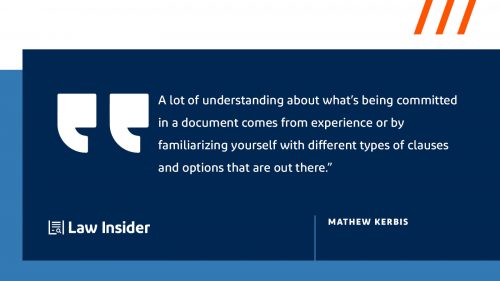
Show Notes
When a company lets go of an upper-level employee, they might have them sign a separation agreement, especially when there’s confidential information to protect. In this episode, Mathew Kerbis tears down a Confidential Separation Agreement & General Release of All Claims. He offers advice on how to smooth an employee’s exit and guarantee company secrets stay privileged. Kerbis also has some great bonus tips on avoiding careless drafting mistakes that you won’t want to miss!
THE CONTRACT: CONFIDENTIAL SEPARATION AGREEMENT AND GENERAL RELEASE OF ALL CLAIMS
THE GUEST: Mathew Kerbis founded Subscription Attorney LLC in 2022. Kerbis started building a legal services subscription model to help provide affordable access to legal advice for small business owners, freelancers, and everyday people when he realized the subscription model could revolutionize the legal profession. That’s why he also launched the podcast Law Subscribed to convince the rest of the legal profession to make the same choice. Kerbis served as an American Bar Association leader for nine years, where he chaired boards, advocated for legal education reform, interviewed ABA Presidents and State Appellate and Supreme Court Justices, and lobbied Congress. He’s also a dancing, acting and singing lawyer with the Chicago Bar Show.
THE HOST: Mike Whelan is the author of Lawyer Forward: Finding Your Place in the Future of Law and host of the Lawyer Forward community. Learn more about his work for attorneys at www.lawyerforward.com.
If you are interested in being a guest on Contract Teardown, please email us at community@lawinsider.com.
Interview Transcript
Mike Whelan Mathew Kerbis, welcome to The Contract Teardown Show. How are you today, sir?
Mathew Kerbis So good. So happy to be here, Mike.
Mike Whelan And we are getting into some nerdiness. This is some new nerdiness, because we have not talked about this subject before. It is—we’re just firing people. We’re firing people left and right. I don’t want to say that it’s relevant in the current economy, but if you’re in certain industries—hello tech—it might well be. We are doing a Confidential Separation Agreement and General Release of All Claims. Let me show it to the folks at home as I do this. Mathew, what is this document? When are we going to run into this kind of thing?
Mathew Kerbis Oh, you’re going to run into this kind of thing if you’re an employer and you have to see somebody go. Usually it’s somebody who knows something more than you want the rest of the general public to know, or if you’re one of the unfortunate people who is being let go, you’re going to see maybe this, too, depending on how high up in the company you are. And again, sort of what information have you been privy to while you’ve been working there?
Mike Whelan You’re going to get this in a cardboard box. Don’t take the company’s stapler. But what about you, Mathew? What brings you to documents like this?
Mathew Kerbis Well, I actually represent both employees and employers. So, yes, my malpractice insurance provider wants me to say I always do a conflict check and I always do. But my whole business model is sort of built for the everyday person to be affordable. So that’s why I tend to be more on the employee side with this type of thing. But I do represent some smaller employers and on occasion have had to draft these for them.
Mike Whelan All right. Well, let’s dig into this document, and we’re going to start with a keyword which is confidential. It mentions it in the title of the document and also down in 6.1. It defines Confidential Separation Information. What do you think about the way this document is dealing with this term confidentiality and how the people who are having to read this document while, you know, through tears as they walk out with their cardboard box. We’ve all been there. Maybe you haven’t been there. I’m fairly unemployable. I’ve been there. What do you think about the way they’re handling the word confidential?
Mathew Kerbis Yeah, yeah. And at least this person, you know in this document is walking away with half a million. So I think they’re not too unhappy. At least I wouldn’t be. But with all that being said, you know, the confidential side of it, people think, Oh, yeah, like I had confidential information. I can’t talk about that. But no, this document itself, the fact that you’re signing it, is also confidential. And that’s something that, at least when I’m representing the employees and they’re getting this type of document, I have to explain that to them—um, former employees, soon to be. And it’s like, you can’t tell your partner, you can’t tell your parent, and you can’t tell your infant child. Really, according to the way this document is worded, you can’t even discuss that this document exists. Now that’s, of course, pending any kind of—and while this particular confidential separation agreement doesn’t go into it, I have seen them drafted where it says, that’s unless, you know, there’s a lawful subpoena that you’re responding to. But even then, usually that has to be cleared with in-house attorneys before you even still disclose that. So that this document exists, the only people who should know in the entire all plane of existence, in every multiverse, is just you and your employer. And that’s it. Do not talk about that this document exists, that you signed it.
Mike Whelan I love the optimism. I’m skeptical, but I love the optimism. Well, let’s talk about an annoyance: the Company. And I’m going to preface this by telling you a story. There is a highly underrated movie called Mickey Blue Eyes with Hugh Grant being taught how to be in the mob. It is hilarious and I love it. But there is a restaurant in the movie called The La Trattoria. The La Trattoria. Let’s talk about The Company.
Mathew Kerbis That is a great reference. I saw that when it was in theaters when I was just a little child.
Mike Whelan Like, oh my gosh, I didn’t even know they had theaters back then! But yeah, Hugh Grant on a wide screen, I mean, you just can’t go wrong.
Mathew Kerbis Oh, yeah, yeah. So I rewatched it recently. It kind of holds up. Kind of holds up. It is funny, though. So, yes, the redundant “the.” I saw this a lot when I was a litigator, where I’ve since moved into transactional work—I’ve always done transactional work—but as a litigator in, like, motions and pleadings, you see the Plaintiff, the Defendant. Well, that’s incorrect. It’s a proper noun. That’s like saying the Mike, the Mathew, you know, the Walmart. Of course, you know, there is like a location to Walmart, it doesn’t work perfectly there. But it’d be like saying, the Microsoft, right? Like it’s not— it’s extra. Does it change the meaning of the contract? No. Is it a little bit confusing? Yes. Technically it’s wrong. And so less words in a contract is always a good thing. So if you can make it less wordy and a shorter contract, I think that’s a good thing. And so take out the “the” before company. They don’t do that with employee so this contract is drafted correctly when it comes to the proper use of a capital E employee. But if a term is defined in the beginning of a contract as instead of X, Y, Z company, we’re calling it “Company” in quotes or Mathew, we’re calling “Employee,” whatever that defined term is, you should not be putting a “the” in front of it. Get rid of the “the.”
Mike Whelan That’s right. And Californians, I want you to pay special attention because you don’t ride “The 10.” There’s only one 10. You ride I-10, you ride ten—you know, there’s a whole SNL bit about this. The The Trattoria is a wonderful restaurant. Well, let’s jump to Section 2.1. We’re talking about severance payments. You had mentioned in preparation that there are a couple of sections in this document that look like they are play-with-able, negotiable. Let’s talk about the first one. Severance Payment, 2.1. What do you think about the way this document handles that?
Mathew Kerbis Yeah, and, and it’s a good point, the whole, the negotiability thing. And especially since I tend to be representing employees more than I represent employers, a lot of employees that I’ve represented in this type of situation think, I, like, I have to sign it, right? I don’t have a choice. Like, this is what the company’s offering. Or, especially if they’ve seen one of these documents before in the nature of their employment, they think, Oh, the company, they don’t negotiate this, like, you can’t negotiate this. This is the amount they give you. Maybe it’s company policy. It’s like your severance payment is going to be however many years you worked here, and that’s the amount of week’s pay that we give you, that kind of a thing. And while that might be company policy, and while that might be what they do—what they’ve done in every severance agreement that maybe you’ve seen doled out, if that was the nature of your work, if you were in human resources or legal or something at the company—everything’s always negotiable. Always negotiable. And especially that number. And depending on what type of leverage you may have against a company, what kind of, you know, specialized knowledge or sort of weird things some of the executives were doing that you know about that they shouldn’t be doing. You might be able to get a higher number. So you’re always going to want to negotiate a higher number on the employee side. And of course, on the employer side, you know, you want them to think, Oh, no, this is what we do for everyone, we try to treat everybody equally with these separation agreements, this is our company policy. But I always encourage the employees to see if there’s a reason they can negotiate a higher number in that regard.
Mike Whelan Speaking of, I saw a tweet recently where someone had been fired from a restaurant and then their manager, their former manager, texted them and said, Hey, did you do inventory? We’re trying to find out how much butter there is. And the guy was like, Bro, seriously, you let me go. When you get rid of somebody, especially at the high level, presumably, that this person is, they know where bodies are buried, and the company, to continue operating, will need to know about the buried bodies. So let’s jump to 6.3 and Continuing Obligations. What do you think about that section and the obligations that it puts on the person who’s leaving and on the company?
Mathew Kerbis You know, specifically here you’ll see things also like, you know, like noncompetes sometimes are in this type of a thing. Now in this particular contract that the audience is looking at, there’s a nonsolicitation in there, so you can’t take any employees with us for the term of one year which are your continuing obligations after separation. So for at least one year, you can’t hire any of our employees to go work on some competitive- type product or what have you. The term of that is also negotiable. Now, especially with things like noncompetes, you get into more state laws and, like, what is a conscionable amount of time and what isn’t. That’s not in this particular contract. But that’s the type of thing that you’re going to be wanting to be thinking about if you’re advising an employer and employee about this type of a clause. And that time period, again, there’s some—there’s case law. Sometimes there are statutes about how much time is allowed and how much isn’t. So know your state law and know your case law. But here, this one time—this one-year time period that’s in this contract that you could, if you’re the employee, you can negotiate that to be shorter. You could have a carve-out, you know, except for, you know, Jane Smith, because I need to take her with me. She’s the best. You know, like, everything is always negotiable, is my point—well, not everything—but generally speaking, things are negotiable. Even if this is what you’re first presented with.
Mike Whelan And it looks like an infinite obligation to protect confidential and proprietary information at the company, is that normal that you can never talk about the company into the future?
Mathew Kerbis That is pretty normal. And again, you know, every state is going to have maybe different rules around this or different case law. But generally speaking, that’s enforceable and that—and especially with, like, a giant payout like this, that’s probably enough consideration that that’s an acceptable term, is to keep everything confidential forever. I mean, there may be trade secrets. You know, there may be all sorts of confidential information. So as far as an enforceability thing, you know, every situation is different and context matters. But in the context of, like, just how much of a payout this is going to be, this is probably for a much higher-up executive, you know, type level or if not like a C-suite executive, you know, very, very upper management type of separation agreement. I think that that’s reasonable. And again, it’s sort of company-specific, too.
Mike Whelan Speaking of enforceability, Section 9 talks about Enforcement and there’s nitpick that you’ve got in there. What do you think about Section 9?
Mathew Kerbis Ah, yes. Yes, I am—if the audience caught from the second tip that I had about a “the” that shouldn’t be there, yes, I’m a little nitpicky here. So in nine, it talks about stopping payments in the event of a breach of a contract. Of this agreement. So the way that this is worded is it’s implying that there’s more than one payment, which if you actually read the payment clauses of how the payment is being made, it’s being made in a one lump sum payment on a very specific date. And so certainly there’s, you know, there’s a way that you could put in this contract, Well, if we’ve started the payment and you’ve breached the contract, then we can do everything within the law that it allows us to, to try to halt that payment from continuing to go through. That’s being specific to this exact contract. So I understand that language making sense in a lot of other types of separation agreements, maybe where there’s multiple payments or you’re unsure about the specific date that a payment is being made, but the way that the—you know, context matters, right? And you look at the on the whole of this contract, we know it’s only one payment on one very specific date. And so at best it’s superfluous because, yes, you know, it’s a little confusing. Like, it’s just one payment. Is this ever even going to happen, if there’s a breach? You know, if there’s a breach, it’s probably going to be long after that payment was made. So does this really need to be in there? Maybe not. But to the extent that it is confusing, I would recommend some type of amendment like the earlier amendment that I mentioned.
Mike Whelan Yeah, and it you know, it brings us to a big picture and I know we’re talking about sections that aren’t there, for example, the ability to rehire this person. When you see these kinds of things where there are gaps, you know, where there are problems that should be solved or you see language that doesn’t quite match up, it leads you to believe that there’s probably some copy/pasting going on here. And you and I both know that in context, I mean, Law Insider is a place that someone can go and find contract language and theoretically just copy/paste it. But what we’re trying to do with this show is suggest to people, do not do that, right? Like you need to be thoughtful about the way you use these sections. But I might challenge myself there, which is, what’s the trade-off, right? If you are the lawyer who’s drafting this document and going in and nitpicking every single clause, it’s going to take X amount of time getting out a contract that’s good enough to get the deal done, or in this case, to get the separation done. Well, how do you balance that risk of, I want this thing to be really adapted to the moment versus, you know, we got to do thousands of these documents. Let’s move on. How do you balance that sort of quality control activity?
Mathew Kerbis Well, for your billable hour attorneys out there—which I’m not, I’m the subscription attorney—you’re going to want to spend as much time as possible on a contract, right? So read it from top to bottom a few times to make sure everything’s—
Mike Whelan —write it backwards. The only way you’re going to know if it’s good is if you write it backwards.
Mathew Kerbis Right. So, you know, but realistically, if you’re putting together a contract from scratch, even if it’s copying and pasting from different types of documents that are available on Law Insider, you know, it’s your job as the attorney to make sure that it all makes sense after it’s copied and pasted together. And does that mean reading it from top to bottom, every single word multiple times? No, no, of course not. But it means being diligent when you’re putting it together in the first place to make note of what’s in there. And a lot of lawyers who I know actually have really good memories. But also, don’t rely on your memory. Take good notes. I’m a big fan of Google Docs, actually, more so than Word, because I could comment and make notes on things that don’t actually change the document, like a track changes-type format. [It’s] a little bit easier and more user-friendly. And so I’ll do that as I’m going through a document to remind myself of something. So instead of having to scroll down from top to bottom, reading the document, I’m scrolling down top to bottom looking at my notes. And so that’s something that you’re going to want to do when you’re copying and pasting, putting things in there together. And it is hard to know, like, what’s being omitted. A lot of that comes from experience or just familiarizing yourself with a lot of the types of different clauses and options that are out there.
Mike Whelan Yeah, it reminds me, I was listening to a podcast about what an artist is in a highly tech-engaged world. And it was talking about that open AI software where you can create images. And there was one about Shrek the Savior, I think, where it like Jesus-ified Shrek. And it was hilarious. And you see all these images. And so there’s this question, when the technology is doing a lot of the paint brushing, where is the artist? And I think to your point, in this scenario, maybe in that scenario, too, it’s in the questions that we ask and the care that we take to make sure that they’re answered. That’s the craft. And so I hope that if this show does anything for you guys, it makes you realize that if you don’t do that, we’re going to make fun of you later. So, Mathew, I appreciate you, thank you for joining us. For people who want to connect with you and learn more about your subscription model and your practice, what’s the best way to connect with you?
Mathew Kerbis Well LinkedIn, DMs are open, I always recommend and like more people connecting with me on there. And then Law Subscribed is the podcast and you could go to Law Subscribed dot com and find it on every single podcasting platform that’s out there.
Mike Whelan Well, we will have a link to the LinkedIn and to the Mathew over at Law Insider dot com slash resources. And if you want to be a guest on The Contract Teardown Show, just email us. We’re at community at Law Insider dot com. We will see you all next time. Thanks again, Mathew.
Mathew Kerbis Thank you.



